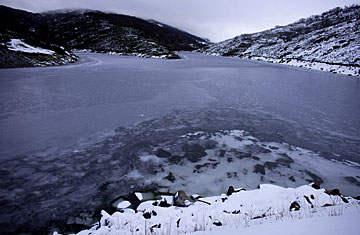
Guthega is the river's first stop as it moves through the dams and power stations of the Snowy Hydro Scheme
(2 of 2)
The next day, sunny weather paints the river valley in eye-watering brightness. The conditions seem welcoming, but, says guide Easton, "It's very unusual for it to be like this." On a trail above the eastern bank of the river, he points out the place where another life was mysteriously lost.
Stephen Crean, brother of now Federal Opposition Trade Spokesman Simon, was cross-country skiing from Charlotte's Pass to Thredbo in August 1985. Easton, who was guiding at the time, believes he saw the 38-year-old heading away from the river toward the track. The next day he told a searcher on a snowmobile where he had last seen Crean, drawing a map to indicate that the skier had been heading up the hill, not west towards Thredbo. Searchers combed the area for weeks, but no trace of Crean was found.
Two years later, police received an unusual delivery in the mail: Crean's battered wallet, containing some faded credit cards and money, accompanied by a note that said "Found this bugger in the park last Tuesday." The sender was an itinerant fruit picker who had found a skull in the national park. He had taken it away because he liked to reconstruct animal skeletons and wanted to practice his hobby on a human subject. The man's notes enabled investigators to locate the rest of Crean's bones in a creek 3 km east of Thredbo. To this day Easton wonders if the searchers paid enough attention to his rough map: "I don't know," he says. "Given the direction he was going, it would have been wise to have a look."
Further down, near the ruins of Kunama Hut, the Snowy begins to sound more like a river. The trickling becomes a noisy rush as the water accelerates between the rocks, gathering the force that old-timers say once made the river banks shudder. But nowadays this singing stream is trapped 10 km downstream at Guthega; 35 km on, at Jindabyne, it is strangled by the series of dams and tunnels, pipelines and aqueducts that make up the Snowy Hydro Scheme.
At the Scheme's Cooma headquarters, 45 km northeast of the river, banks of computers and ranks of scientists and engineers monitor the flows from the Snowy and other rivers that provide 70% of all renewable energy on the eastern mainland grid of Australia. The scheme took 25 years to complete, cost what was in 1974 the enormous sum of $A820 million, and relied upon labor provided by thousands of new migrants.
But the rivers' flow is hostage to the vagaries of rainfall, and in an office in front of nine computer screens, phone-carrying scientists on call around the clock are attempting to improve the odds. The promise of ideal snow conditions sends them racing to their control panel, whose monitors track clouds and temperature, wind and air pressure. With the click of a mouse, they cause a tiny burst of silver iodide crystals to be delivered into the clouds from mountain- top generators. It's hoped the experiment, costing $A20 million over six years, will increase the annual snowpack by 10%, releasing an extra 70 gigaliters of water.
According to cloud-seeding director John Denholm, poor snowfall has left some dams at record lows. "You've only got to see Lake Eucumbene. We are at around the lowest levels since construction. This is a way to increase the return in the natural environment. Our indications to date are pretty good," he says. "There was an experiment from 1955 to 1959 that reported an increase of 19% in precipitation."
The flow rate has been a constant source of controversy for those living downstream, where the river swings east toward the small farming town of Dalgety. Environmentalists and residents have mounted spirited campaigns to increase the Snowy's flow, which fell to 2% after the scheme was implemented. The campaigns have brought government promises to increase the flow to 21%, but the battle continues.
From Dalgety the river heads south for 35 km before curling back west into the vastness of Kosciuszko National Park, far from human habitation. Snaking along reed-lined shallows between forested mountains blue in the dusk, the river gains width and wildness. Brumbies, wallabies and dingoes freeze in the headlights on the dirt road that traces the river's western bank.
At the strangely named Suggan Buggan, a large dead dingo hangs in a tree beside the road. According to farmer Dave Woodburn, who has lived in the area since arriving with his English migrant parents to take up a selection in the 1950s, the hanging up of dogs is just a local custom. "It's sort of a blokey thing to do. Sometimes it will be to show how good they are at catching dogs or to stick it up the dogmen's noses. It's a wonder nobody took the scalp and tail off it, because they're worth 50 bucks," he says.
At 66, Woodburn is old enough to remember when the Snowy was a wild torrent in the winter melt. "We used to have the regular winter flood, that's pretty spectacular; and some of the granite country it flows through and some of those rocks are absolutely beautiful, water-washed for thousands of years." Only the lower parts of those rocks are washed these days, and the river is slower as its 435-km journey comes to an end. Around Orbost, the land flattens and the river spreads into broad estuarine lakes, as if hesitating before its brown stream glides gently across the sandbars into the cold waters of Bass Strait.